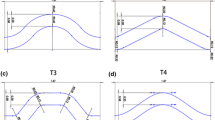Abstract
Coronary stents are used to re-establish the vascular lumen and flow conditions within the coronary arteries; the typical thickness of a stent strut is 100 μm, and average grain sizes of approximately 25 μm exist in stainless steel stents. The purpose of this study is to investigate the effect of strut size on the stress strain behavior of 316 L stainless steel. Other materials have shown a size dependence at the micron size scale; however, at present there are no studies that show a material property size dependence in coronary stents. Electropolished stainless steel stent struts within the size range of 60–500 μm were tensile tested. The results showed that within the size range of coronary stent struts a size dependent stress–strain relationship is required to describe the material. Finite element models of the final phase of fracture, i.e., void growth models, explained partially the reason for this size effect. This study demonstrated that a size based stress–strain relationship must be used to describe the tensile behavior material of 316 L stainless steel at the size scale of coronary stent struts. © 2003 Biomedical Engineering Society.
PAC2003: 8719Rr, 8780Rb, 8719Uv
Similar content being viewed by others
References
Balcon, R., R. Beyar, S. Chierchia, I. De Scheerder, P. G. Hugenholtz, F. Kiemeneij, J. Meyer, J. P. Monassier, and W. Wijns. Recommendations on stent manufacture, implantation and utilization. Eur. Heart J.18:1536–1547, 1997.
Besson, J., L. Devillers-Guerville, and A. Pineau. Modeling of scatter and size effect: Application to thermal embrittlement of duplex stainless steels. Eng. Fract. Mech.67:169–190, 2000.
Fajadet, J.et al. 210–day follow-up of the RAVEL study: A randomized study with the Sirolimus-eluting Bx VELOCITY (TM) balloon-expandable stent in the treatment of patients with de novo native coronary artery lesions. J. Am. Coll. Cardiol.39:20A-20A, 2002.
Fleck, N. A., G. M. Muller, M. F. Ashby, and J. W. Hutchinson. Strain gradient plasticity—Theory and experiment. Acta Metall. Mater.42:475–487, 1994.
Möller, D., W. Reimers, A. Pyzalla, and A. Fischer. Residual stresses in coronary artery stents. J. Biomed. Mater. Res.58:69–74, 2001.
Murphy, B. P., P. Savage, B. P. O'Donnell, and P. E. McHugh. Computational modelling and experimental testing to determine the constitutive and failure behaviour of 316 L stainless steel for stent applications. Acta Bioeng. Biomech.4:654–655, 2002.
Rausmussen, K. J. R. Full range of stress–strain curves for stainless steel alloys, Research Rep. No. R811, The University of Sydney, 2001.
Savage, P., B. P. O'Donnell, P. E. McHugh, B. P. Murphy, and D. Quinn (2003). The size dependence of the stress–strain behaviour of coronary stent struts investigated using a micromechanical finite element model. (unpublished).
Schluter, N., F. Grimpe, W. Bleck, and W. Dahl. Modelling of the damage in ductile steels. Comput. Mater. Sci.7:27–33, 1996.
Serruys, P. W., and M. J. B. Kutryk. Handbook of Coronary Stents. London: Martin Dunitz Ltd., 2000.
Stölken, J. S., and A. G. Evans. A microbend test method for measuring the plasticity length scale. Acta Mater.46:5109–5115, 1998.
Weldon, L. M. The effects of passivation processes on the mechanical performance of stainless steels for stent applications. M.Eng.Sc. thesis, NUI, Galway, Ireland, 2001.
Author information
Authors and Affiliations
Rights and permissions
About this article
Cite this article
Murphy, B.P., Savage, P., McHugh, P.E. et al. The Stress–Strain Behavior of Coronary Stent Struts is Size Dependent. Annals of Biomedical Engineering 31, 686–691 (2003). https://doi.org/10.1114/1.1569268
Issue Date:
DOI: https://doi.org/10.1114/1.1569268




